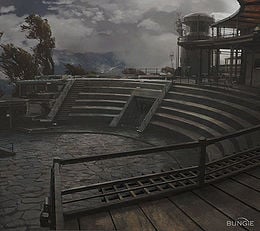Theater
From Halopedia, the Halo wiki
Theater is a feature available for use in Halo 3, Halo 3: ODST and Halo: Reach.
Description
Every time a player plays a game of Campaign or Multiplayer, the game will automatically be saved into a list of up to twenty-five recent films, which players can watch at their leisure. Players can save up to one-hundred saved films in Halo 3. Now, in Halo: Reach a player can save thousands of items, one thousand of each file type, including clips, films, maps, and gametypes, and not have to delete things. Players have a number of abilities while in-film; play, pause, fast-forward, take screenshot, rewind and record film clip, however only the later two are only available in Multiplayer clips in Halo 3 and Halo 3: ODST, due to loading issues in Campaign. Theater is also featured in Halo: Reach and is improved as "Theater 2.0". One improvement revealed at Gamescon 2010 is the ability to rewind films in Campaign and Firefight modes. Film clips are shorter, recorded sections of a film, only usable in Halo 3 and Halo: Reach, not in Halo 3: ODST.
Pressing "Y" while watching a film will enable players to roam around the space in real-time. Despite popular belief, saved films are only collections of game information readable only through the Xbox 360, thus cannot recorded onto a PC without the use of Bungie Pro film rendering, or a video capture card. Screenshots can be saved to a computer as an actual image if posted from a file share on Bungie.net. Popular or highly rated films will be shown in the Bungie Favorites list.
Trivia
- Theater can be used to make certain tricks.
- If you pause a Theater film while a character is speaking, they will continue to speak until the end of that sentence, and if that character is present at the scene, their mouths will still move, but nothing else will. This can cause a glitch where Truth's hologram will appear, and he will make his speech while you have the game paused, and then when you press play, he will make gestures that originally sync with the speech, but without saying anything.
- This is also true for running the video faster or slower than normal speed. Rather than slowing down or speeding up the sound, which would change the pitch, it simply plays the sound whenever it starts. So if the footage is slowed, sounds are spread apart, where if it is sped up the sounds are compressed, with more sounds playing at the same time.
- This also occurs during gameplay sequences if an character is in mid-vocalization when pausing. This can easily been seen when pausing during an assassination involving Elites, as their mandibles will move while the rest of their body is still.
- Theater has made machinima much easier to produce, as Halo: Combat Evolved and Halo 2 required people to film scenes using the first person perspective of another player in-game.
- The gametype "Slayer" is replaced with the name "Blam!" in Theater, even though it is the name of a regular gametype. The same goes for "Assault".
